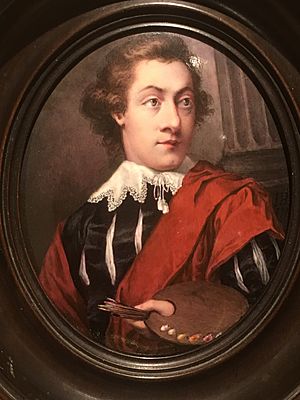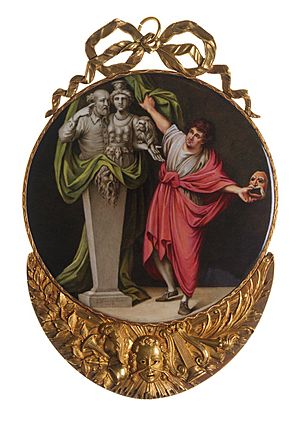John Howes (painter) facts for kids
John Howes (born 1750, died 1833) was an English artist. He was known for his paintings and tiny portraits called miniatures. One of his famous works shows a famous actor, David Garrick. He also painted scenes inspired by a popular poem called The Seasons.
Contents
A Look at John Howes' Life and Art
John Howes was born in London in 1750. His father was a clockmaker and goldsmith. When John was 14, he started training to be a goldsmith too.
Becoming an Artist
In 1770, John Howes joined the Royal Academy of Arts School. This was a new and important art school. He learned painting there. In 1772, he even won a silver medal for his art!
From 1772 to 1793, John Howes showed his art at the Royal Academy. He displayed 32 different artworks during these years.
Famous Paintings
One of his most important works was painted in 1777. It was an enamel painting (a type of painting using glass powder) called David Garrick unveiling a herm of Shakespeare and the Ephesian Diana. This painting celebrated the famous actor David Garrick's retirement. People had good things to say about this painting.
Other Notable Artworks
John Howes also painted other enamel pieces. These include a Portrait of Lady Rushout from 1774. Another work was Venus attended by the Graces, painted in 1793.
In 1784, John Howes won another award. He received the Silver Pallett from the Royal Society of Arts. He won it for his historical drawing called The Queen of Sheba visiting Solomon.
Howes also created two beautiful paintings based on a popular poem. The poem was called The Seasons by Thomson. His paintings were Palemon and Lavinia in a Landscape and Celadon and Amelia in a Landscape. These were painted around 1795.
Later Life
John Howes got married in 1776 to Elizabeth Mills. He lived in London for many years. Later, he moved to Kentish Town. There, he started a family with his second wife, Sarah.
After 1795, there are no more records of his artwork. He later moved to Hertfordshire. He lived there until he passed away in December 1833.



